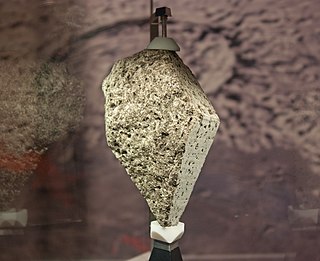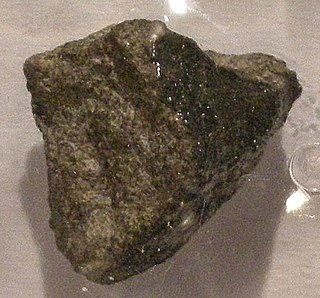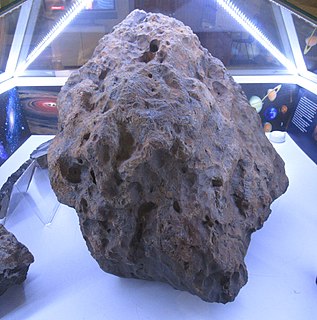
A meteorite is a solid piece of debris from an object, such as a comet, asteroid, or meteoroid, that originates in outer space and survives its passage through the atmosphere to reach the surface of a planet or moon. When the original object enters the atmosphere, various factors such as friction, pressure, and chemical interactions with the atmospheric gases cause it to heat up and radiate energy. It then becomes a meteor and forms a fireball, also known as a shooting star or falling star; astronomers call the brightest examples "bolides". Once it settles on the larger body's surface, the meteor becomes a meteorite. Meteorites vary greatly in size. For geologists, a bolide is a meteorite large enough to create an impact crater.

Boxhole is a young impact crater located approximately 180 km north-east of Alice Springs in the Northern Territory, Australia. It is 170 metres in diameter and its age is estimated to be 5,400 ± 1,500 years based on the cosmogenic 14C terrestrial age of the meteorite, placing it in the Holocene. The crater is exposed to the surface.

Campo del Cielo refers to a group of iron meteorites and the area in Argentina where they were found. The site straddles the provinces of Chaco and Santiago del Estero, located 1,000 kilometers (620 mi) north-northwest of Buenos Aires, Argentina and approximately 500 kilometres (310 mi) southwest of Asunción, Paraguay. The crater field covers 3 by 18.5 kilometres and contains at least 26 craters, the largest being 115 by 91 metres.

Dalgaranga crater is a small meteorite impact crater located on Dalgaranga pastoral station 75 km northwest of Mount Magnet in Western Australia. It is only 24 m in diameter and 3 m deep, making it Australia's smallest impact crater. Though discovered in 1921, it was not reported in the scientific literature until 1938. The bedrock at the site is weathered Archaean granite of the Yilgarn Craton. The discovery of fragments of mesosiderite stony-iron meteorite around the crater confirms an impact origin, making this crater unique as the only one known to have been produced by a mesosiderite projectile.

Alyth is a town in Perth and Kinross, Scotland, five miles northeast of Blairgowrie and about 17 miles northwest of Dundee. In 2016 the town had an estimated population of 2,400.

The Canyon Diablo meteorite refers to the many fragments of the asteroid that created Meteor Crater, Arizona, United States. Meteorites have been found around the crater rim, and are named for nearby Canyon Diablo, which lies about three to four miles west of the crater.

The Murchison meteorite is a meteorite that fell in Australia in 1969 near Murchison, Victoria. It belongs to a group of meteorites rich in organic compounds. Due to its mass and the fact that it was an observed fall, the Murchison meteorite is one of the most studied of all meteorites.

Moon rock or lunar rock refers to rock that is found on Earth's Moon. This includes lunar material collected during the course of human exploration of the Moon, and rock that has been ejected naturally from the Moon's surface and landed on Earth as meteorites.

Mundrabilla is in a very sparsely populated area in the far south east of Western Australia. The two significant features are Mundrabilla Roadhouse and Mundrabilla Station, which are approximately 35 kilometres (22 mi) apart. At the 2016 census, Mundrabilla had a population of 23, 32% male and 68% female. The time zone in use is UTC+08:45.

The oldest dated rocks formed on Earth, as an aggregate of minerals that have not been subsequently broken down by erosion or melted, are more than 4 billion years old, formed during the Hadean Eon of Earth's geological history. Meteorites that were formed in other planetary systems can pre-date Earth. Particles from the Murchison meteorite were dated in January 2020 to be 7 billion years old.

Nakhla is a Martian meteorite which fell in Egypt in 1911. It was the first meteorite reported from Egypt, the first one to suggest signs of aqueous processes on Mars, and the prototype for Nakhlite type of meteorites.

Perth Museum and Art Gallery is the main museum and exhibition space in the city of Perth, Scotland. It is located in the Marshall Monument, named in memory of Thomas Hay Marshall, a former provost of Perth.

Stannern meteorite fell on May 22, 1808 into the Moravian village Stonařov, in today's Czech Republic.

The Sylacauga meteorite fell on November 30, 1954, at 12:46 local time in Oak Grove, Alabama, near Sylacauga, in the United States. It is commonly called the Hodges meteorite because a fragment of it struck Ann Elizabeth Fowler Hodges (1920–1972).

The Muonionalusta meteorite is a meteorite classified as fine octahedrite, type IVA (Of) which impacted in northern Scandinavia, west of the border between Sweden and Finland, about one million years BCE.

The Mundrabilla meteorite is an iron meteorite found in 1911 in Australia, one of the largest meteorites found, with a total known weight of 22 tonnes and the main mass accounting for 12.4 tonnes.

The Chelyabinsk meteorite is the fragmented remains of the large Chelyabinsk meteor of 15 February 2013 which reached the ground after the meteor's passage through the atmosphere. The descent of the meteor, visible as a brilliant superbolide in the morning sky, caused a series of shock waves that shattered windows, damaged approximately 7,200 buildings and left 1,500 people injured. The resulting fragments were scattered over a wide area.
Events from the year 1917 in Scotland.
Padvarninkai meteorite is a meteorite that fell on 9 February 1929 near the village of Padvarninkai located near Andrioniškis, Anykščiai District Municipality, Lithuania. It is a rare eucrite that contains maskelynite and is highly shocked.
The Winchcombe meteorite is a meteorite that was observed entering the Earth's atmosphere as a fireball over Gloucestershire, England at 21:54 hours on 28 February 2021. Due to a public appeal, fragments were quickly recovered from the village of Winchcombe enabling it to be collected for analysis before becoming degraded.

















